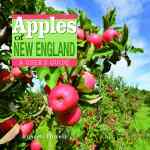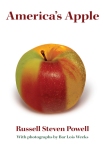

APPLES AND RAISINS go extremely well together, as in this recipe for Apple Raisin Cake. I used three PaulaRed and one Pristine apple, two of the better early season apples now ready in New England apple orchards. Other popular early varieties now or soon to be available include Akane, Ginger Gold, Gravenstein, Jersey Mac, Melba, Sansa, Williams’ Pride and Zestar!
With just a couple of weeks to go before the main harvest begins in September, New England’s growers are expecting a good crop, the result of good weather during spring bloom, adequate rain, and little hail to date. We will publish an up-to-the-minute crop forecast for the region in two weeks, on August 30.
Apple Raisin Cake was adapted from a recipe for Apple Coffee Cake in the National Institute of Health publication, “Keep the Beat: Heart Healthy Recipes.” The cake is delicious, but to us it does not resemble a coffee cake — it is too moist and full of fruit. It should be served on a plate and eaten with a fork.
One of the changes we made is to keep the peels on, since that is where most of the apple’s nutrition is stored. Chopped into pieces, the peels soften nicely as the cake bakes, and they add color and texture as well as nutrients to this pleasing dessert.
I cut the sugar in the original recipe from 1 c to ¾ c, and the cake was plenty sweet. The natural sugars of the apples and raisins are strong enough, in fact, that next time I will add even less sugar, just ½ c, allowing more fruit flavor to come through.
Apple Raisin Cake

3-4 sweet-tart apples such as PaulaRed or Pristine, cored and chopped (about 5 c)
1 c raisins
¾ c sugar
½ c pecans, chopped
⅓ c softened butter
2 t vanilla
1 egg, beaten
1 c flour
1 c whole wheat flour
2 t cinnamon
1 t baking soda
1 c milk
Preheat oven to 350°F. Lightly butter a 13×9 baking dish.
In large mixing bowl, combine apples with sugar, raisins, and pecans. Mix well and set aside for 30 minutes.
In a medium bowl, combine flours, cinnamon, and baking soda.
Add milk to dry ingredients and stir to form thick batter. Add a little more milk if batter is too thick.
To apple mixture, add butter, vanilla, and egg.
Add batter to apple mixture a third at a time, stirring just enough to moisten.
Pour into prepared baking dish and bake 35-40 minutes, or until apples are soft and a toothpick inserted in the middle comes clean. Cool slightly before serving.
***
TWO BOOKS by senior writer Russell Steven Powell, with photographs by Bar Lois Weeks, executive director of the New England Apple Association, explore the history of apple growing in the region and take an expansive look at the nation’s apple industry.
 Apples of New England (Countryman Press) is a regional history and guidebook, with photographs and descriptions of more than 200 apples discovered, grown, or sold in New England.
Apples of New England (Countryman Press) is a regional history and guidebook, with photographs and descriptions of more than 200 apples discovered, grown, or sold in New England.
Apples of New England includes chapters on the history of apple growing in New England, and on the “fathers” of American apples, Massachusetts natives John Chapman (“Johnny Appleseed”) and Henry David Thoreau.
 America’s Apple (Brook Hollow Press) presents a detailed picture of how apples are grown in America, through stories of the people who grow them. There are chapters on horticulture, history, and the best ways to eat, drink, and cook with apples.
America’s Apple (Brook Hollow Press) presents a detailed picture of how apples are grown in America, through stories of the people who grow them. There are chapters on horticulture, history, and the best ways to eat, drink, and cook with apples.
America’s Apple looks at how America’s orchards are changing as a result of the trends toward intensive planting and the trademarking of new varieties, and what that means to consumers. Powell also writes about the fragile underpinnings of modern agriculture: the honeybees needed to pollinate the crop and the labor required to pick it, plus new and exotic pests and increasingly volatile weather.
Apples of New England and America’s Apple are available in hardcover at fine bookstores and orchards and online. America’s Apple is also available in paperback.
For more information, write to russellstevenpowell@gmail.com.
***
 Good Apples: Behind Every Bite is another outstanding apple book due in September from University of Iowa Press. Author Susan Futrell has more than three decades of experience in marketing and food distribution, and currently works for the nonprofit Red Tomato. She does a thorough job describing the complex system needed to get fruit from farm to table, from grower to picker, packer to marketer. She explores many of the challenges along the way, from labor to pests to climate change.
Good Apples: Behind Every Bite is another outstanding apple book due in September from University of Iowa Press. Author Susan Futrell has more than three decades of experience in marketing and food distribution, and currently works for the nonprofit Red Tomato. She does a thorough job describing the complex system needed to get fruit from farm to table, from grower to picker, packer to marketer. She explores many of the challenges along the way, from labor to pests to climate change.
The book is well-researched, and Futrell’s writing is lively and engaging. Still living in her native Iowa, she describes a life-long passion for apples rooted in the state’s particular geography and history, yet recognizable to anyone. It reads like a fascinating adjunct to America’s Apple, with a Midwestern twang.